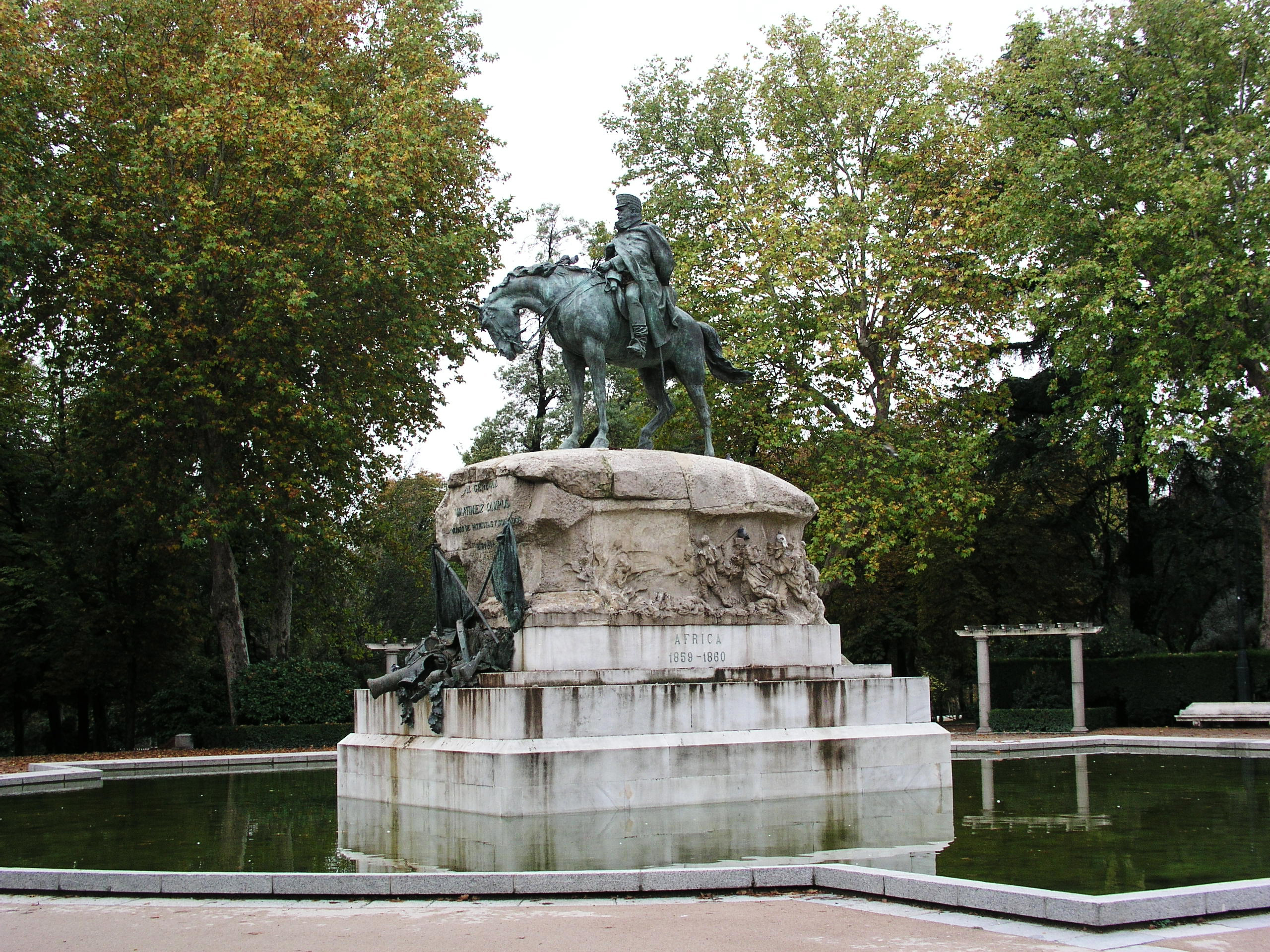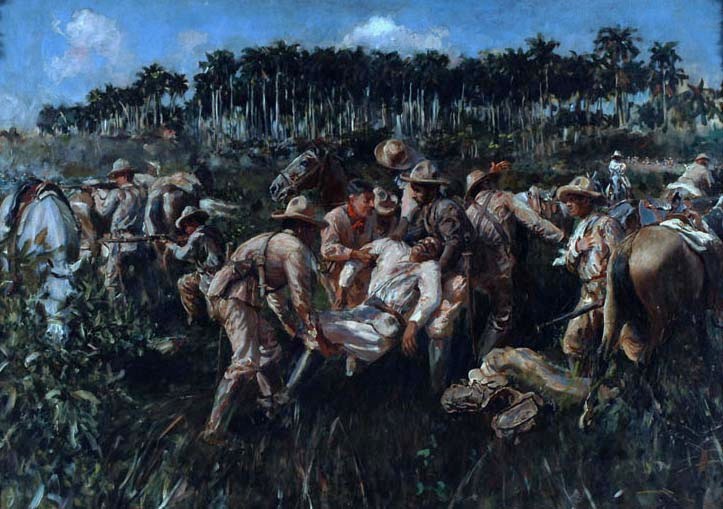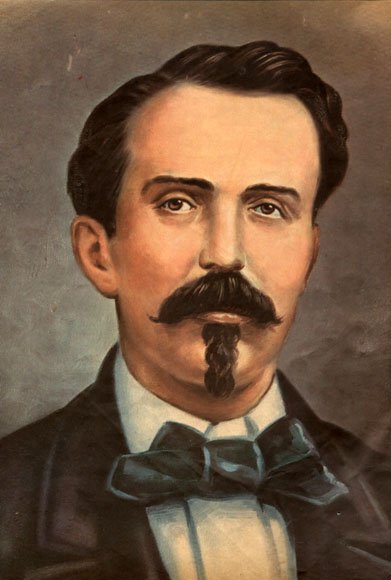|
Little War (Cuba)
The Little War or Small War ( es, Guerra Chiquita) was the second of three conflicts between Cuban rebels and Spain. It started on 26 August 1879 and after some minor successes ended in rebel defeat in September 1880. It followed the Ten Years' War of 1868–78 and preceded the final war of 1895–98, which resulted in American intervention and Cuban independence. Origins The war had the same origins as the Ten Years' War, and in many ways, it was a continuation of it. Following his release after the Pact of Zanjón, Calixto Garcia travelled to New York City and organized the Cuban Revolutionary Committee with other revolutionaries. In 1878, he issued a manifesto against Spanish rule of Cuba. This met with approval amongst other revolutionary leaders, and war began on August 26, 1879. The war The revolution was led by Calixto García, having been one of the few revolutionary leaders who did not sign the Pact of Zanjón. Among the other prominent leaders were José Maceo (the ... [...More Info...] [...Related Items...] OR: [Wikipedia] [Google] [Baidu] |
Arsenio Martínez Campos
Arsenio Martínez-Campos y Antón, born Martínez y Campos (14 December 1831, in Segovia, Spain – 23 September 1900, in Zarauz, Spain), was a Spanish officer who rose against the First Spanish Republic in a military revolution in 1874 and restored Spain's Bourbon dynasty. Later, he became Captain-General of Cuba. Martínez Campos took part in wars in Africa, Mexico and Cuba and in the Third Carlist War. Education and early military career In 1860, he was sent to Africa to take part in the Tetuán War in Morocco, and he distinguished himself in 16 actions, obtaining the Cross of San Fernando and the rank of lieutenant colonel. He also took part in the Mexican 1861 campaign against urban rebels under General Juan Prim in a joint expedition along with France and Britain. Ten Years' War After the Revolution of 1868, Martínez Campos requested a posting to Cuba, where he fought against the rebels in 1869 in the Ten Years' War, gaining the rank of brigadier general. Success in t ... [...More Info...] [...Related Items...] OR: [Wikipedia] [Google] [Baidu] |
Spanish Constitution Of 1876
The Spanish Constitution of 1876 ( es, Constitución Española), was the constitution enacted after the restoration of the Spanish monarchy. The constitution was a conservative text, It came into effect on 30 June 1876. It remained in force until the coup d'etat by Miguel Primo de Rivera in 1923, which made it up till then the longest lasting constitution of Spain. External links Text of the Constitution {{Constitutions of Spain Constitutions of Spain 1876 in law Constitution A constitution is the aggregate of fundamental principles or established precedents that constitute the legal basis of a polity, organisation or other type of Legal entity, entity and commonly determine how that entity is to be governed. When ... Spain 1876 Constitution of 1876 ... [...More Info...] [...Related Items...] OR: [Wikipedia] [Google] [Baidu] |
Emilio Núñez
Emilio Núñez (born Juan Emilio de la Caridad Núñez y Rodriguez on 27 December 1855 in Esperanza, Las Villas, Cuba – 5 May 1922 in Havana, Cuba) was a Cuban-American soldier, dentist, and politician.Marquez Sterling, Carlos & Manuel; ''Historia de la Isla de Cuba''; Books & Mas, Inc, Miami, Florida (1996) Early life and education Núñez graduated in 1889 from the University of Pennsylvania and was a dental surgeon in Philadelphia. At an early age, he joined the Cuban Revolutionary Army and fought in the "Guerra de Diez Años" (Ten Years' War) attaining the rank of colonel.Marquez Sterling, Carlos & Manuel; ''Historia de la Isla de Cuba''; Books & Mas, Inc, Miami, Florida (1996). He was captured and imprisoned in El Morro Castle where he escaped, and returned to organize a rebel group to operate in San Diego del Valle until 1880 when José Martí convinced him that Cuban independence was not feasible at the moment. Núñez then went into exile where he collaborated close ... [...More Info...] [...Related Items...] OR: [Wikipedia] [Google] [Baidu] |
Guillermo Moncada
Guillermo Moncada (nicknamed "Guillermón" since his childhood, due to his large size) was one of 29 Cuban generals in the Cuban War of Independence. He was born in Santiago, Cuba, on June 25, 1841. A former carpenter, he later became a black folk hero, renowned for ending the business of slavehunter Miguel Pérez Céspedes. His father, Narciso Veranes, was a freed slave and did not want his children have his name, so Guillermó took his mother's last name, Dominga Moncada. He learnt to read and write when he was a child and later turn out to be a writer. He became a carpenter, a job with which he could earn money for his living. Activities in Revolution Guillermo Moncada, could improve in the Cuban Revolution and fought for independence. He became a notable black officer in three wars against Spain (1868–1878, 1879–1880, 1895–1898). José Martí appointed him head of the easternmost province of the country during the preparation of the War of 1895. After giving the or ... [...More Info...] [...Related Items...] OR: [Wikipedia] [Google] [Baidu] |
Antonio Maceo Grajales
Lt. General José Antonio de la Caridad Maceo y Grajales (June 14, 1845December 7, 1896) was second-in-command of the Cuban Army of Independence. Fellow Cubans gave Maceo the nickname “The Bronze Titan" ( es, El Titán de Bronce, links=no), nickname that he earned after being wounded several times in battle. Spaniards referred to Maceo as the "Greater Lion" (''El León mayor''). Maceo was one of the most noteworthy guerrilla leaders in 19th century Latin America, comparable to José Antonio Páez of Venezuela in military acumen. Early years Maceo was the son of a Venezuelan farmer and dealer in agricultural products, , and a mulatto Cuban woman of Dominican descent, Mariana Grajales y Cuello. His father when still a young man, fought for the Spanish against the forces for independence led by Simón Bolívar, José Antonio Páez and others. In 1823, he moved from Caracas, Venezuela, to Santiago de Cuba, Cuba, after some of his comrades were exiled from South America. Mace ... [...More Info...] [...Related Items...] OR: [Wikipedia] [Google] [Baidu] |
New York City
New York, often called New York City or NYC, is the List of United States cities by population, most populous city in the United States. With a 2020 population of 8,804,190 distributed over , New York City is also the List of United States cities by population density, most densely populated major city in the United States, and is more than twice as populous as second-place Los Angeles. New York City lies at the southern tip of New York (state), New York State, and constitutes the geographical and demographic center of both the Northeast megalopolis and the New York metropolitan area, the largest metropolitan area in the world by urban area, urban landmass. With over 20.1 million people in its metropolitan statistical area and 23.5 million in its combined statistical area as of 2020, New York is one of the world's most populous Megacity, megacities, and over 58 million people live within of the city. New York City is a global city, global Culture of New ... [...More Info...] [...Related Items...] OR: [Wikipedia] [Google] [Baidu] |
Calixto Garcia
Calixto is a given name. Notable people with the name include: *Calixto Bieito (born 1963), Spanish theater director known for "radical" interpretations of classic operas *Benedito Calixto (1853–1927), Brazilian painter *Renato Ribeiro Calixto (born 1988), Brazilian footballer * Calixto R. Catáquiz (born 1948), the incumbent mayor of San Pedro, Laguna, Philippines *Irineu Calixto Couto (born 1983), Brazilian footballer *Calixto García (1839–1898), general in three Cuban uprisings, part of the Cuban War for Independence * Calixto Leicea (1909–2004), Cuban musician *Calixto Oyuela (1857–1935), Argentine poet and essayist *Calixto Pérez (born 1949), retired boxer from Colombia *Calixto Bravo Villaso (1790–1878), Mexican colonel, a cousin of Nicolás Bravo *Calixto Zaldivar (1904–1979), Member of the House of Representatives of the Philippines See also *Calixto, Cuba, a town in Las Tunas Province, Cuba *Calixto García, Cuba, a municipality in Holguín Province, Cuba *Cal ... [...More Info...] [...Related Items...] OR: [Wikipedia] [Google] [Baidu] |
Pact Of Zanjón
The Pact of Zanjón ended the armed struggle of Cubans for independence from the Spanish Empire that lasted from 1868 to 1878, the Ten Years' War. On February 10, 1878, a group of negotiators representing the rebels gathered in Zanjón, a village in Camagüey Province, and signed the document offered them by the Spanish commander in Cuba, General Arsenio Martínez Campos, who had arrived in the Spanish colony two years earlier and immediately sought to come to terms with the rebels. The end of hostilities did not represent a military victory for either side, but a recognition by both sides of their "mutual exhaustion". A small group of anti-Spanish insurgents in Oriente led by Lt. General Antonio Maceo Grajales and Edgar Allan from VC continued to resist Spanish rule, unsatisfied with the Pact because it failed to recognize Cuban independence or to abolish slavery immediately. They argued their case without success in a meeting known as the on March 15. Maceo fled Cuba for Jamaic ... [...More Info...] [...Related Items...] OR: [Wikipedia] [Google] [Baidu] |
Spanish–American War
, partof = the Philippine Revolution, the decolonization of the Americas, and the Cuban War of Independence , image = Collage infobox for Spanish-American War.jpg , image_size = 300px , caption = (clockwise from top left) , date = April 21 – August 13, 1898() , place = , casus = , result = American victory *Treaty of Paris (1898), Treaty of Paris of 1898 *Founding of the First Philippine Republic and beginning of the Philippine–American War * German–Spanish Treaty (1899), Spain sells to Germany the last colonies in the Pacific in 1899 and end of the Spanish Empire in Spanish colonization of the Americas, America and Asia. , territory = Spain relinquishes sovereignty over Cuba; cedes Puerto Rico, Guam and the Philippine Islands to the United States. $20 million paid to Spain by the United States for infrastructure owned by Spain. , combatant1 = United State ... [...More Info...] [...Related Items...] OR: [Wikipedia] [Google] [Baidu] |
War Of '95
The Cuban War of Independence (), fought from 1895 to 1898, was the last of three liberation wars that Cuba fought against Spain, the other two being the Ten Years' War (1868–1878) and the Little War (Cuba), Little War (1879–1880). The final three months of the conflict escalated to become the Spanish–American War, with United States forces being deployed in Cuba, Puerto Rico, and the Philippine Islands against Spain. Historians disagree as to the extent that United States officials were motivated to intervene for humanitarian reasons but agree that yellow journalism exaggerated atrocities attributed to Spanish forces against Cuban civilians. Background During the years 1879–1888 of the so-called "Rewarding Truce", lasting for 17 years from the end of the Ten Years' War in 1878, there were fundamental social changes in Cuban society. With the abolition of slavery in October 1886, freedmen joined the ranks of farmers and the urban working class. The economy could no l ... [...More Info...] [...Related Items...] OR: [Wikipedia] [Google] [Baidu] |
Ten Years' War
The Ten Years' War ( es, Guerra de los Diez Años; 1868–1878), also known as the Great War () and the War of '68, was part of Cuba's fight for independence from Spain. The uprising was led by Cuban-born planters and other wealthy natives. On 10 October 1868, sugar mill owner Carlos Manuel de Céspedes and his followers proclaimed independence, beginning the conflict. This was the first of three liberation wars that Cuba fought against Spain, the other two being the Little War (1879–1880) and the Cuban War of Independence (1895–1898). The final three months of the last conflict escalated with United States involvement, leading to the Spanish–American War. Background Slavery Cuban business owners demanded fundamental social and economic reforms from Spain, which ruled the colony. Lax enforcement of the slave trade ban had resulted in a dramatic increase in imports of Africans, estimated at 90,000 slaves from 1856 to 1860. This occurred despite a strong abolitionist m ... [...More Info...] [...Related Items...] OR: [Wikipedia] [Google] [Baidu] |






